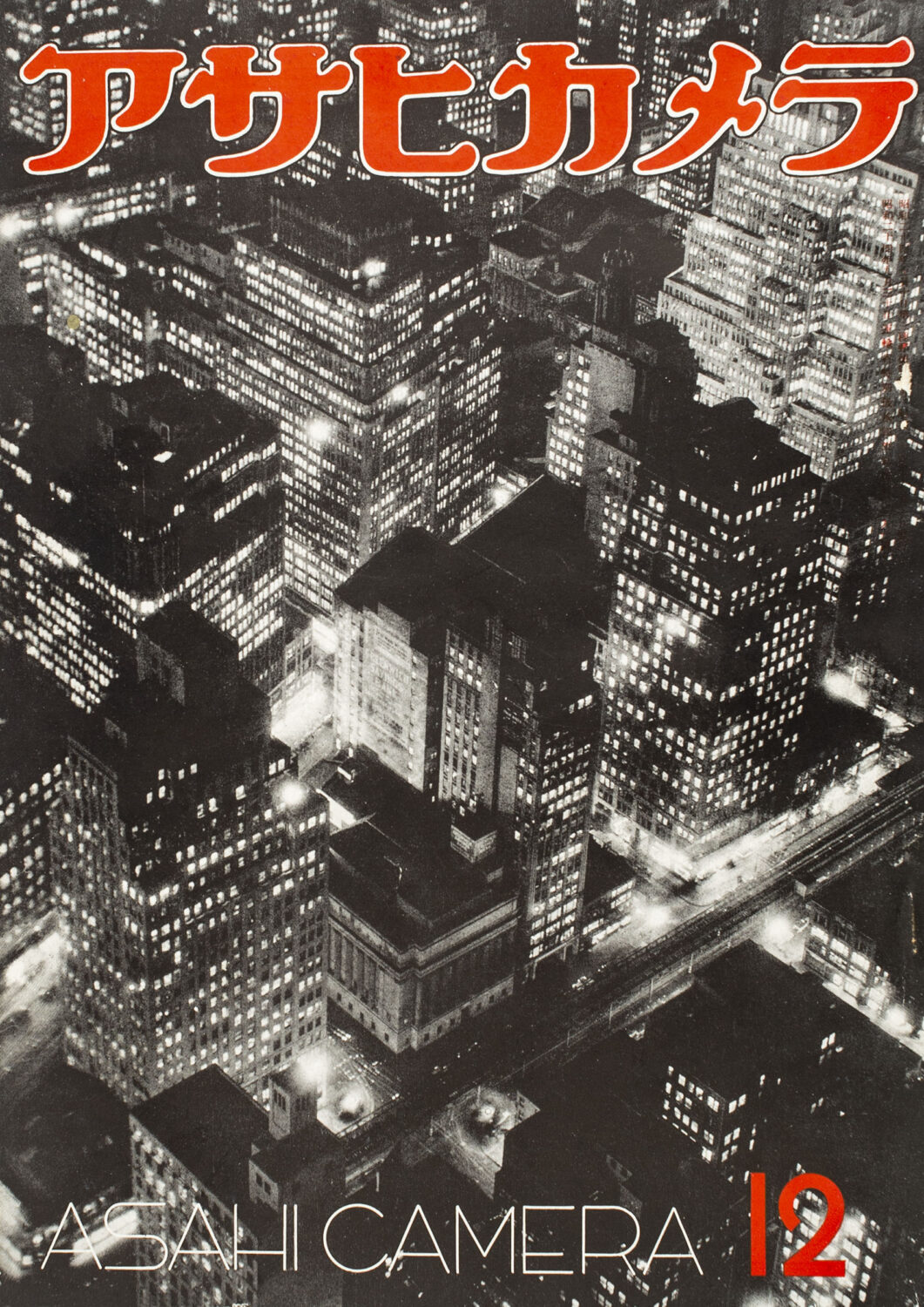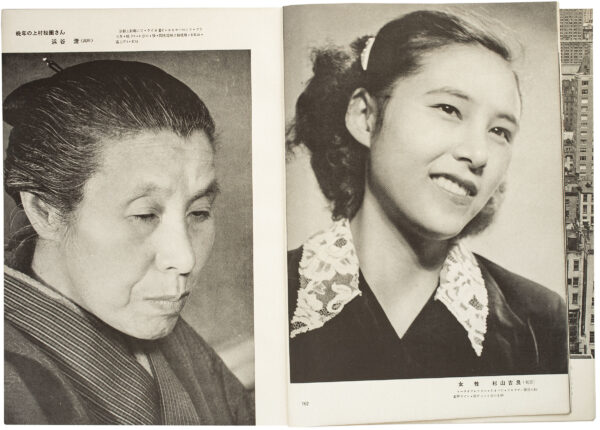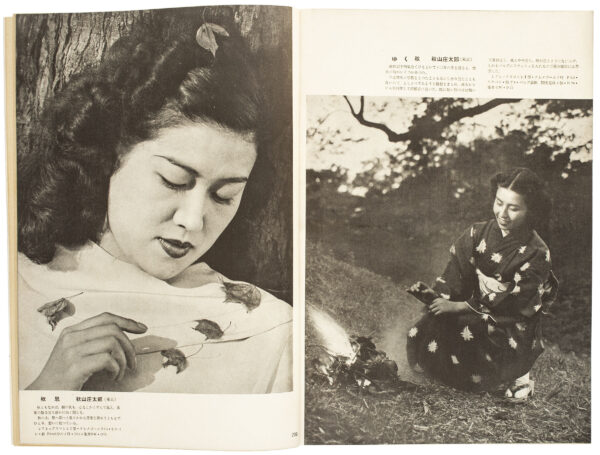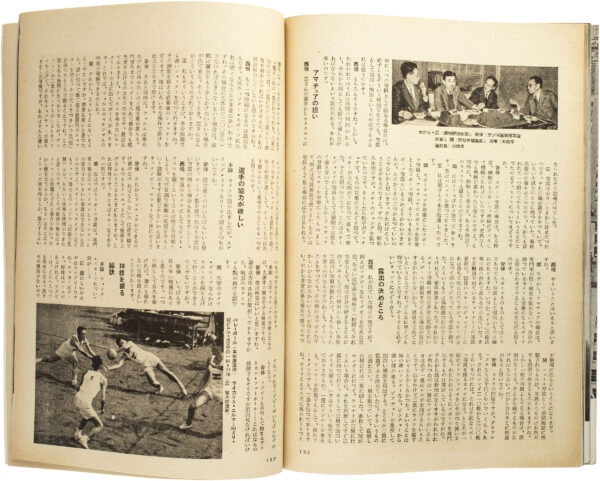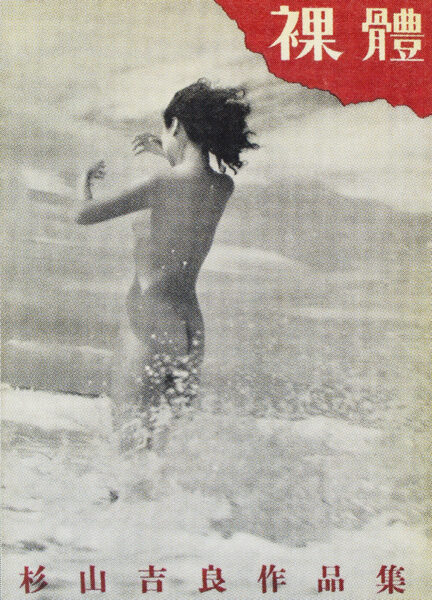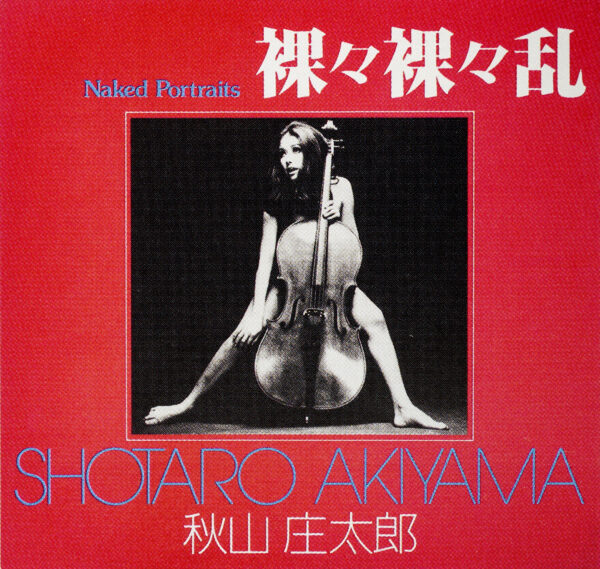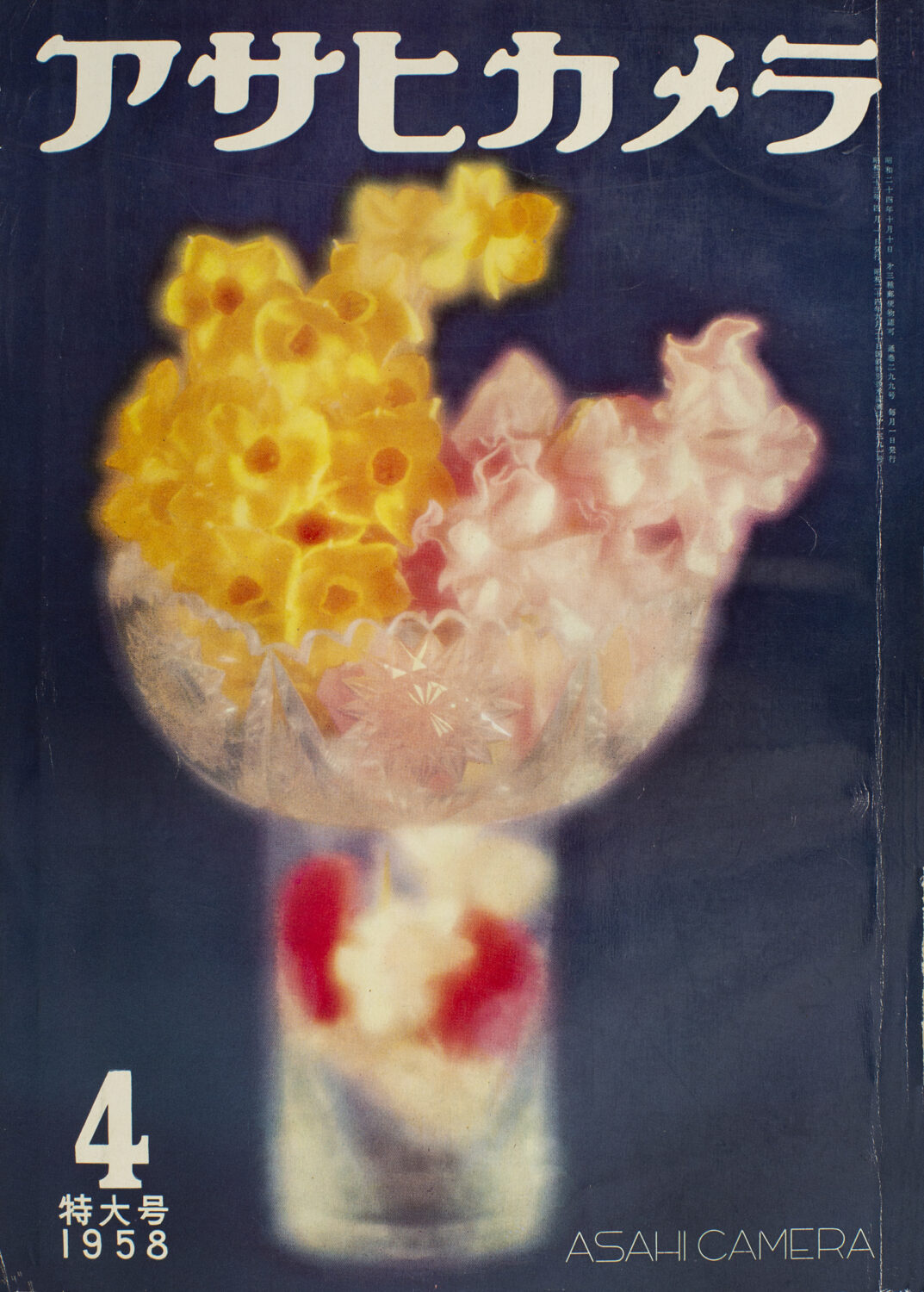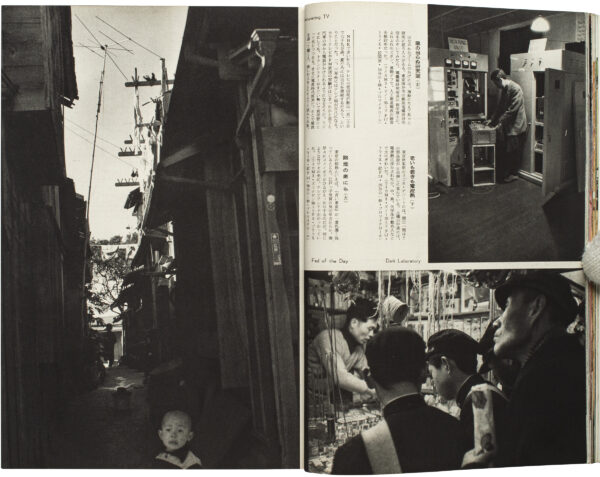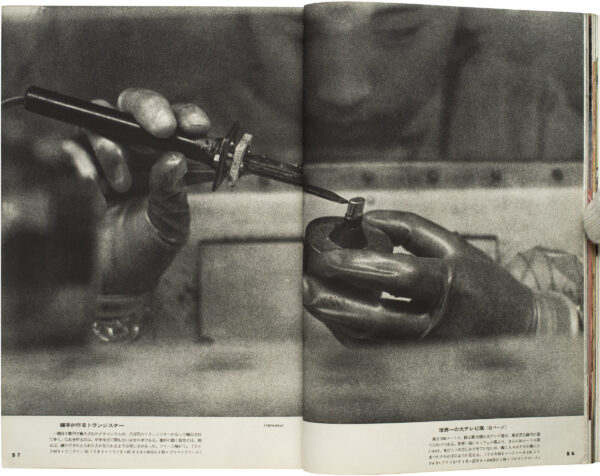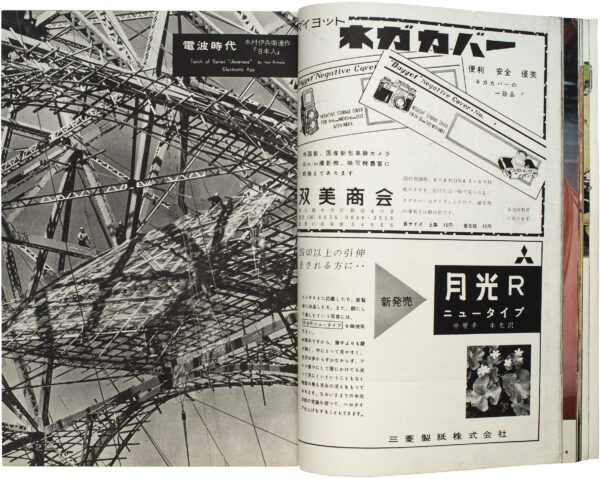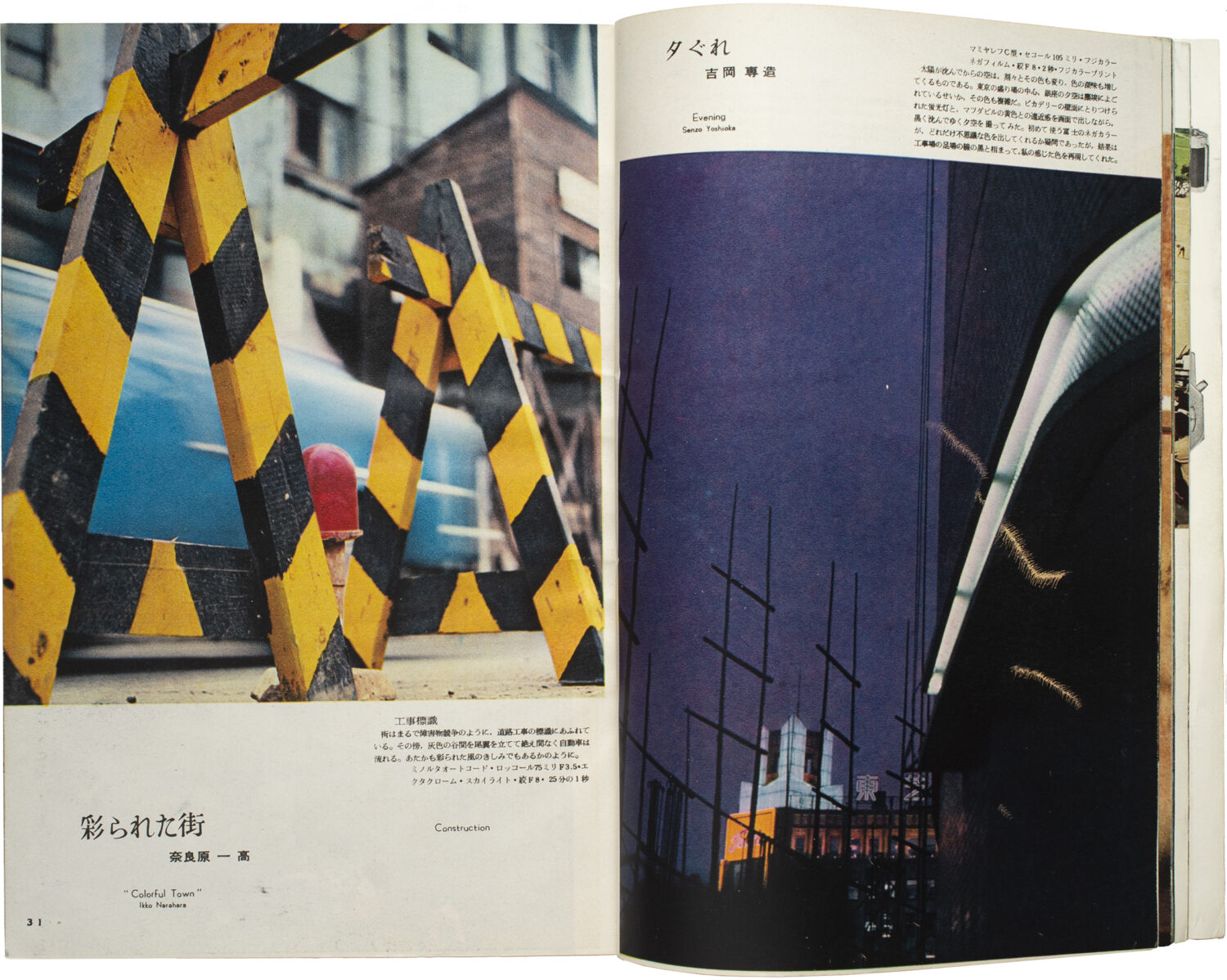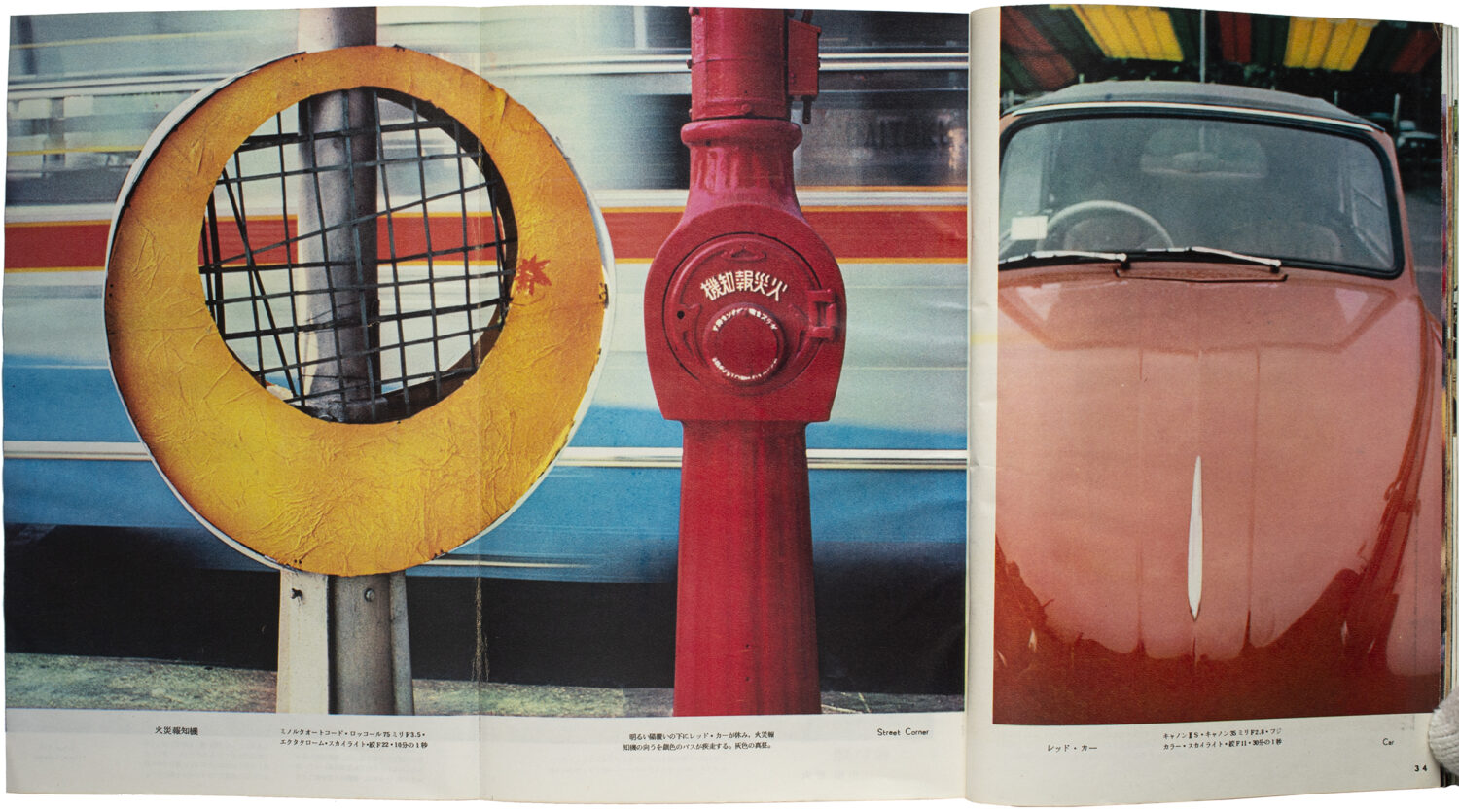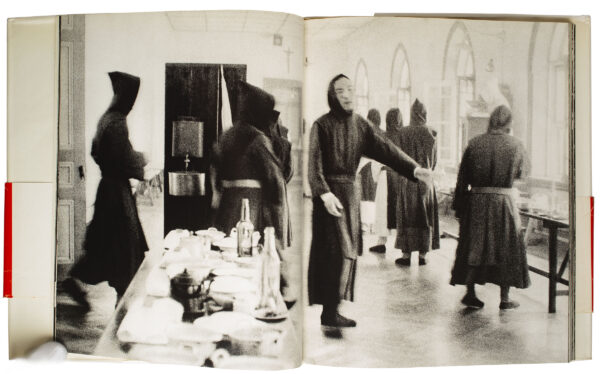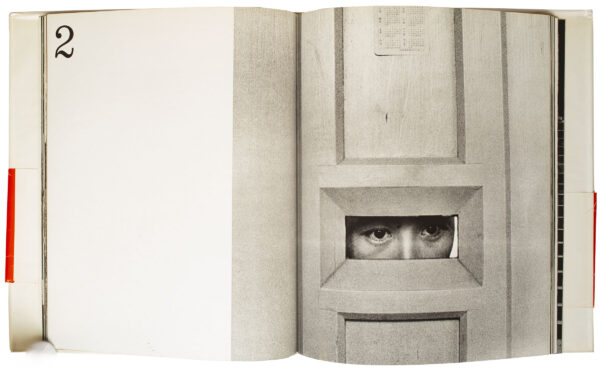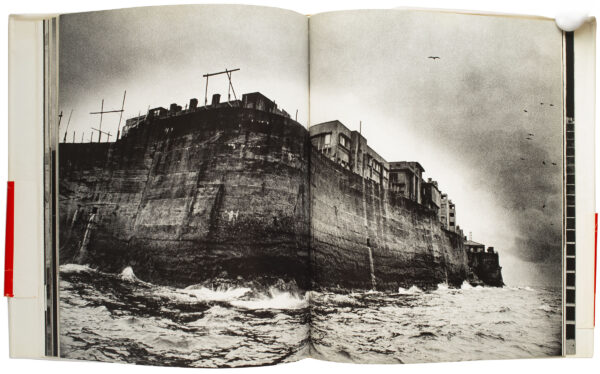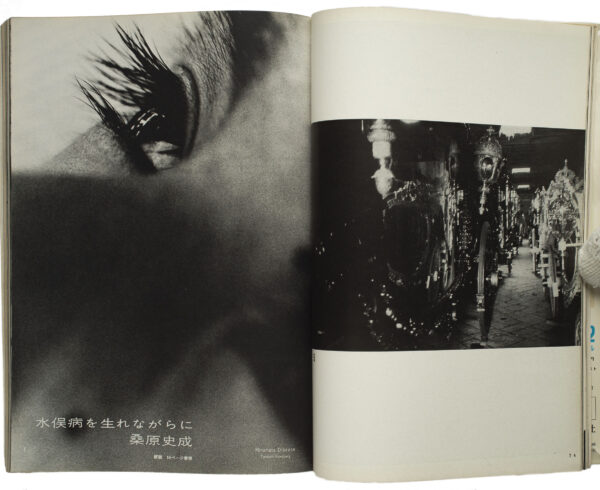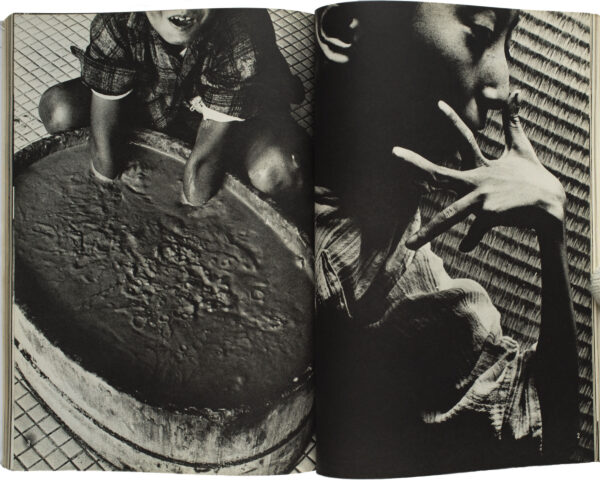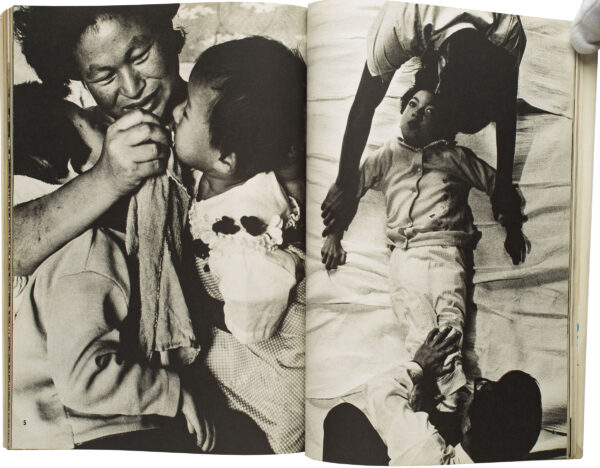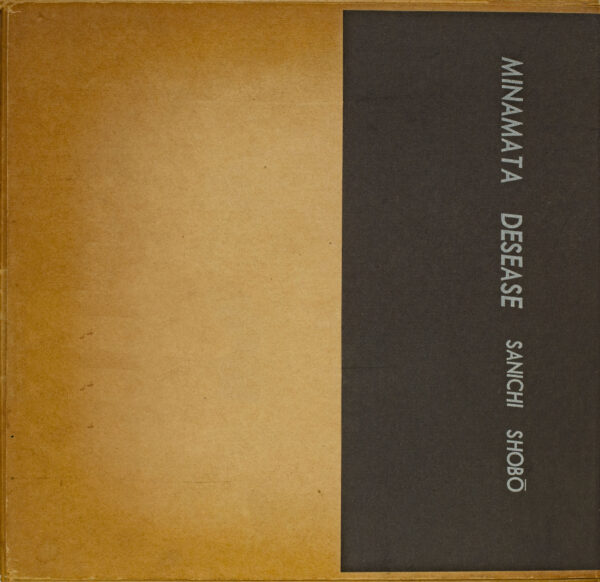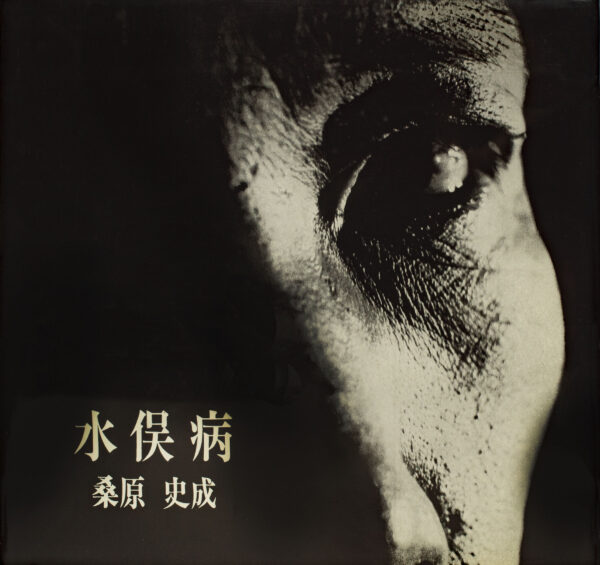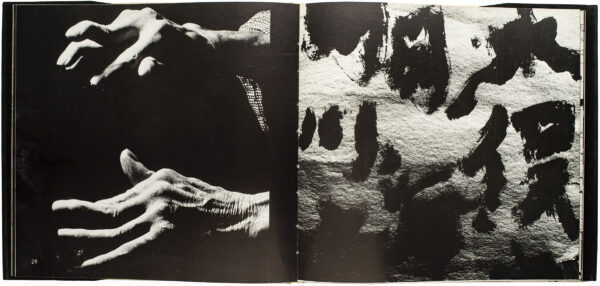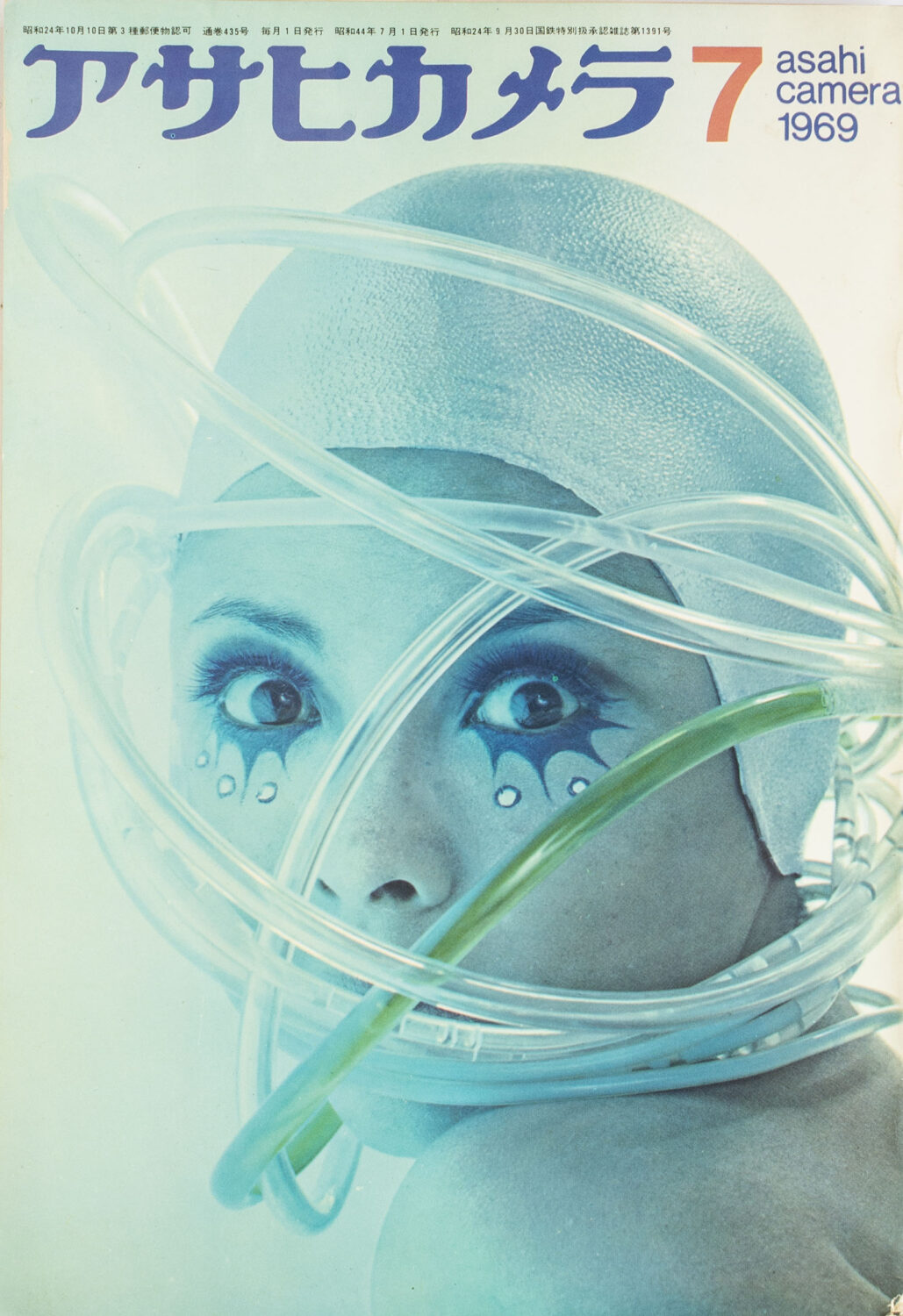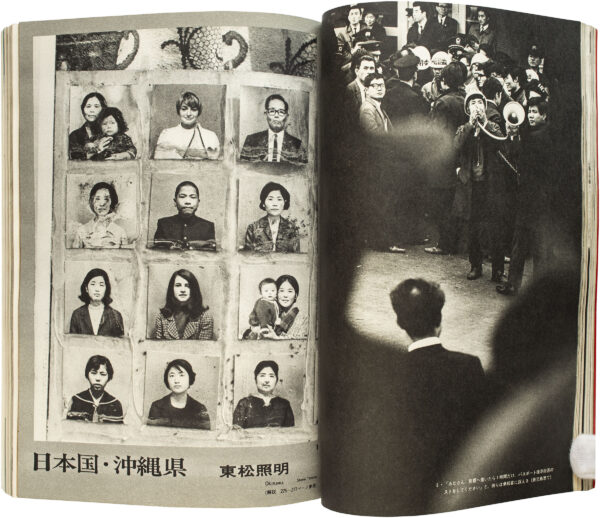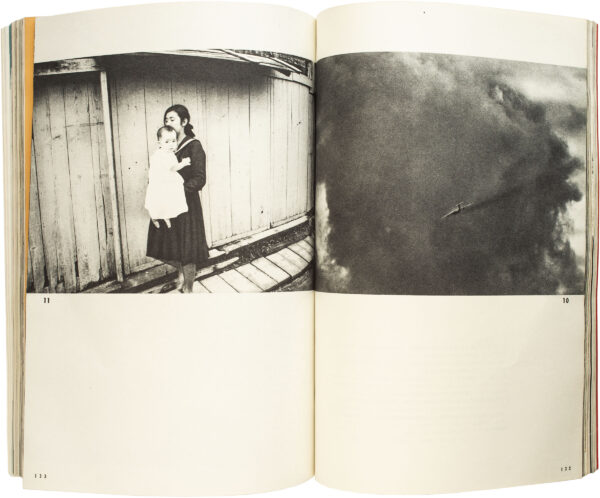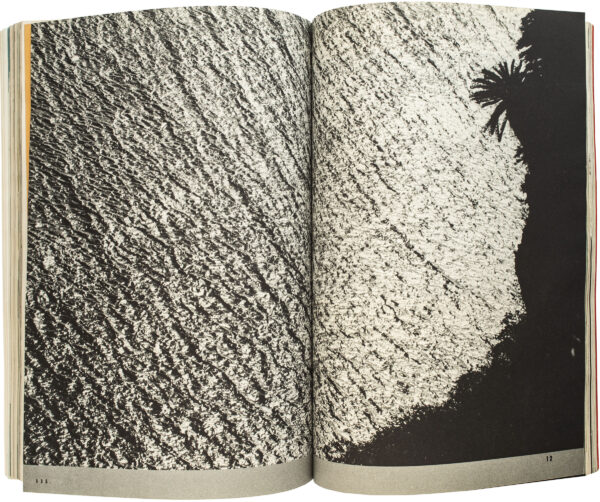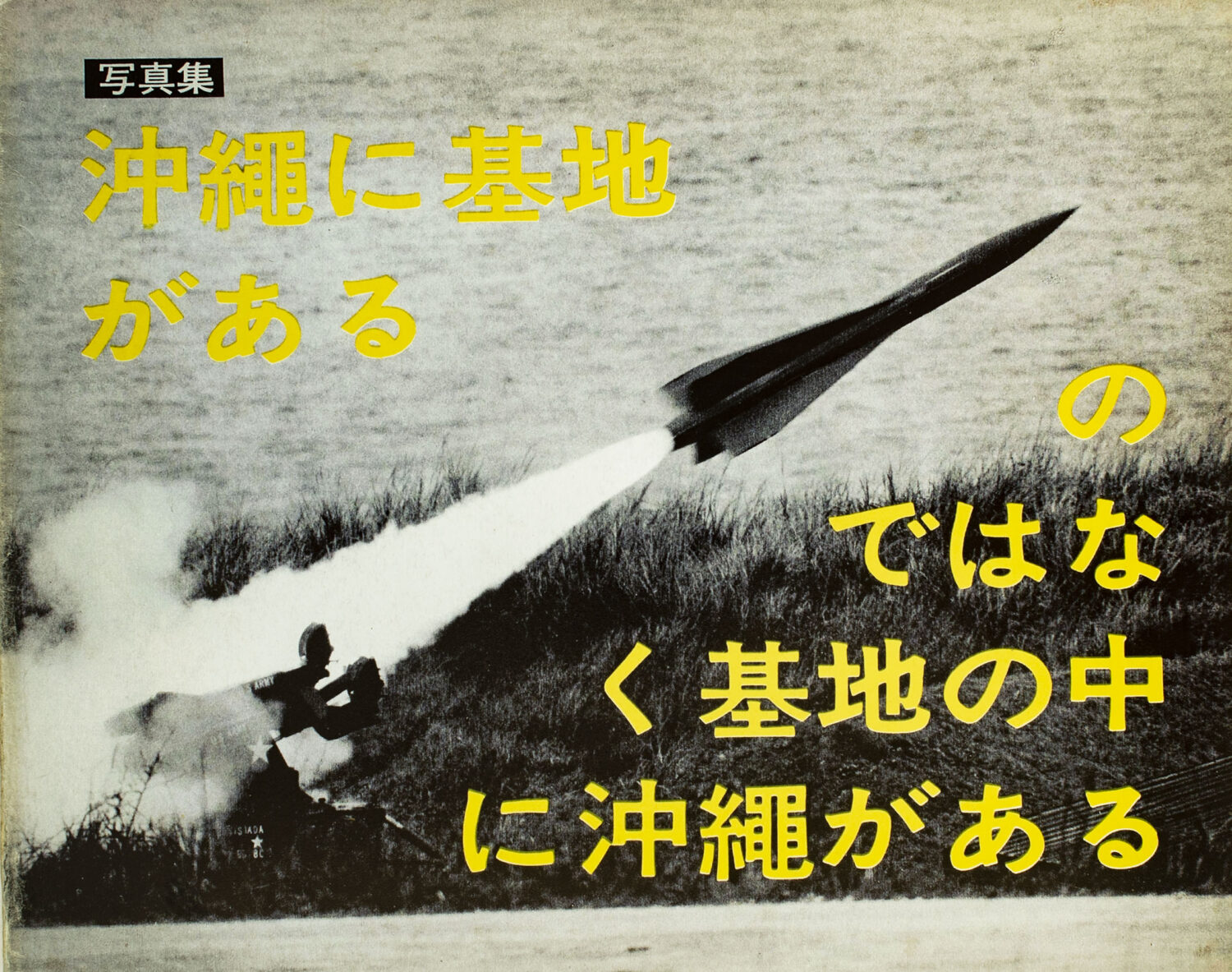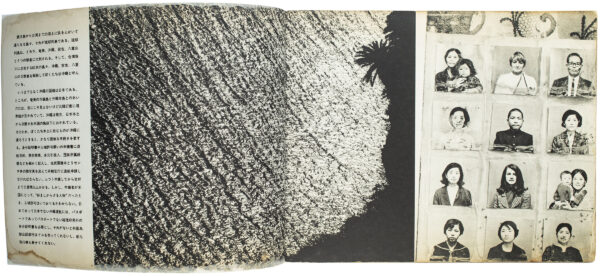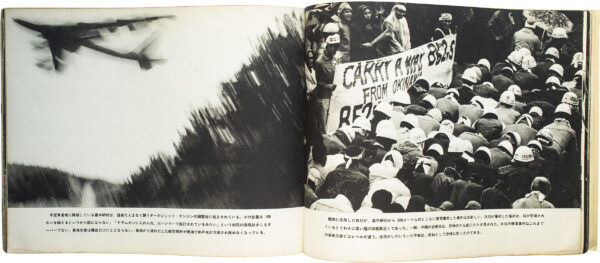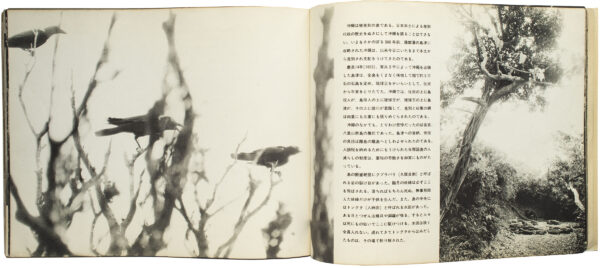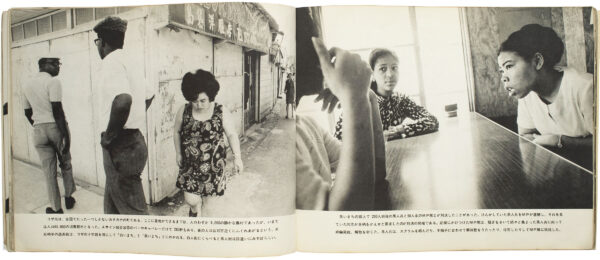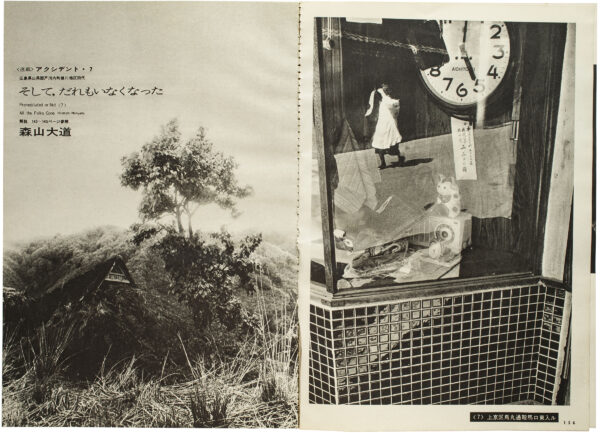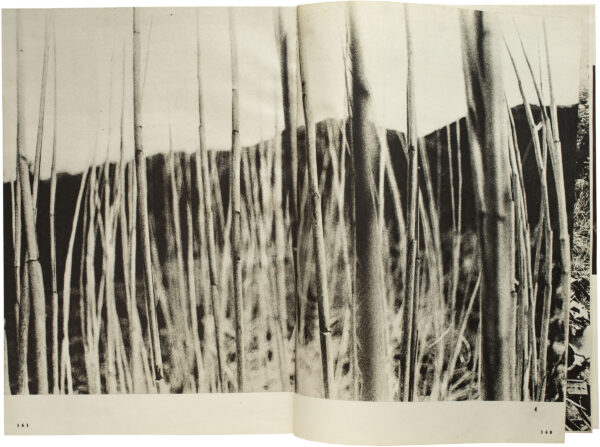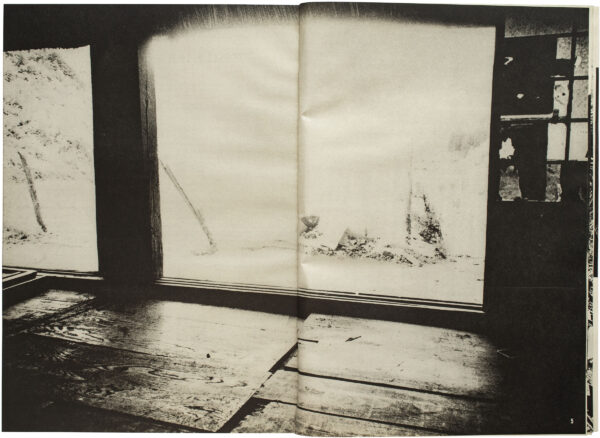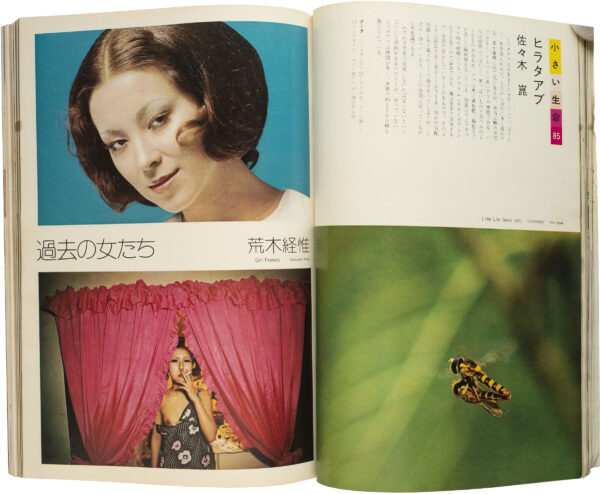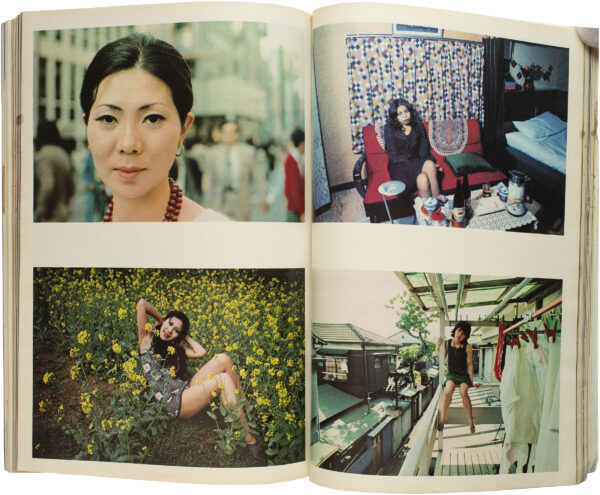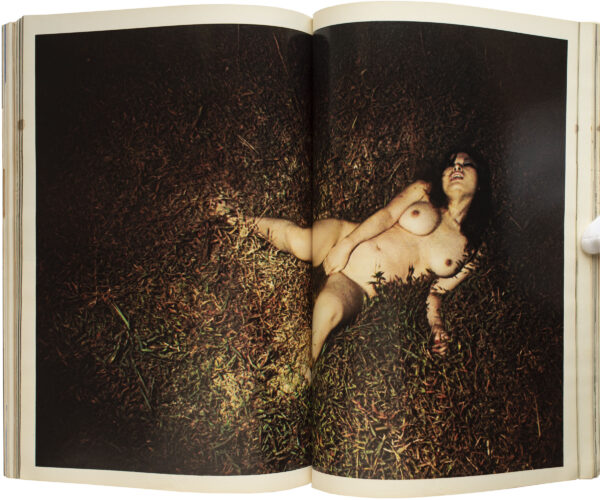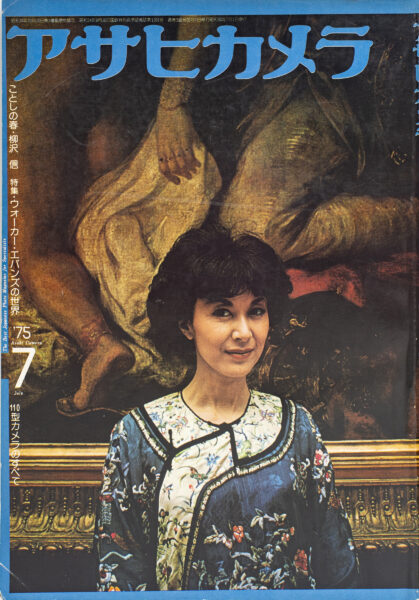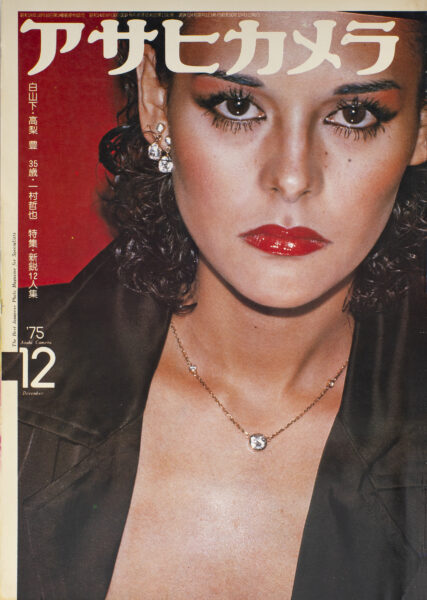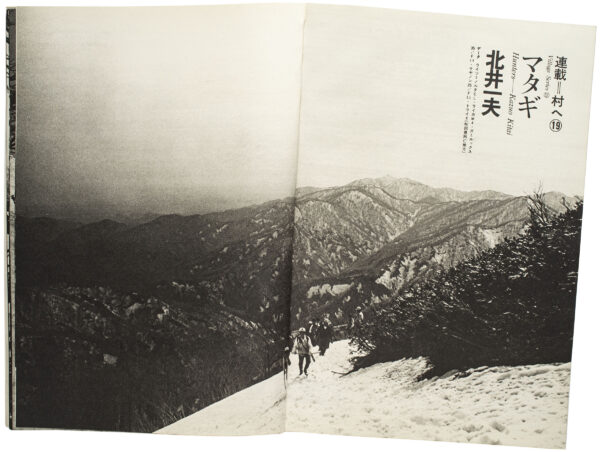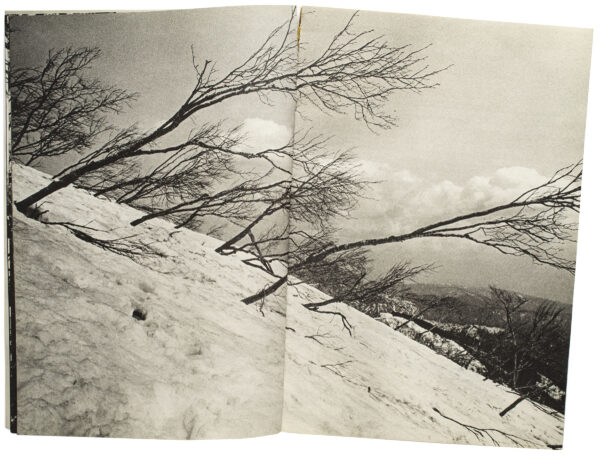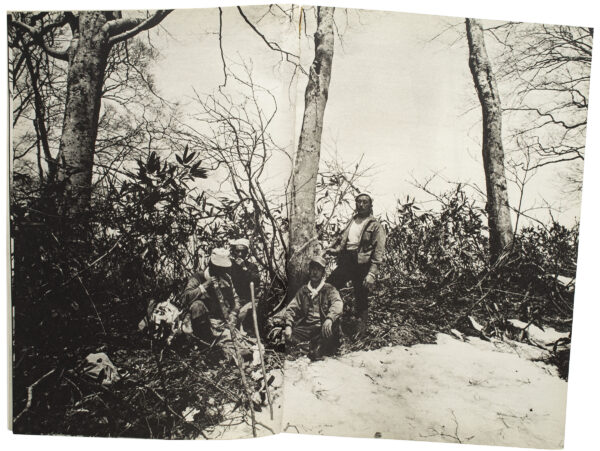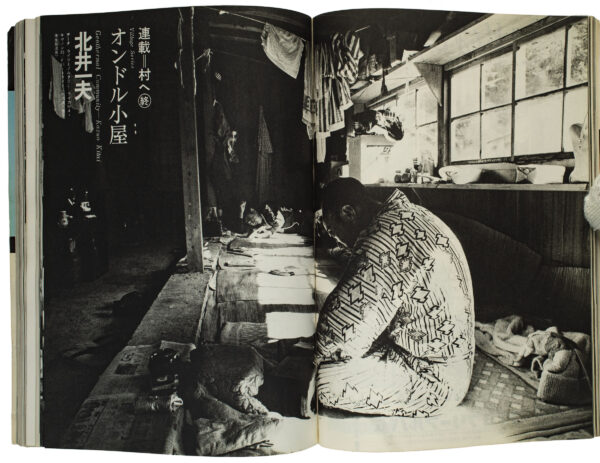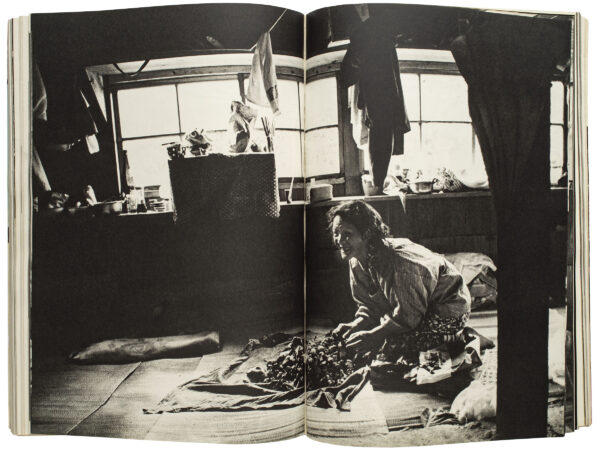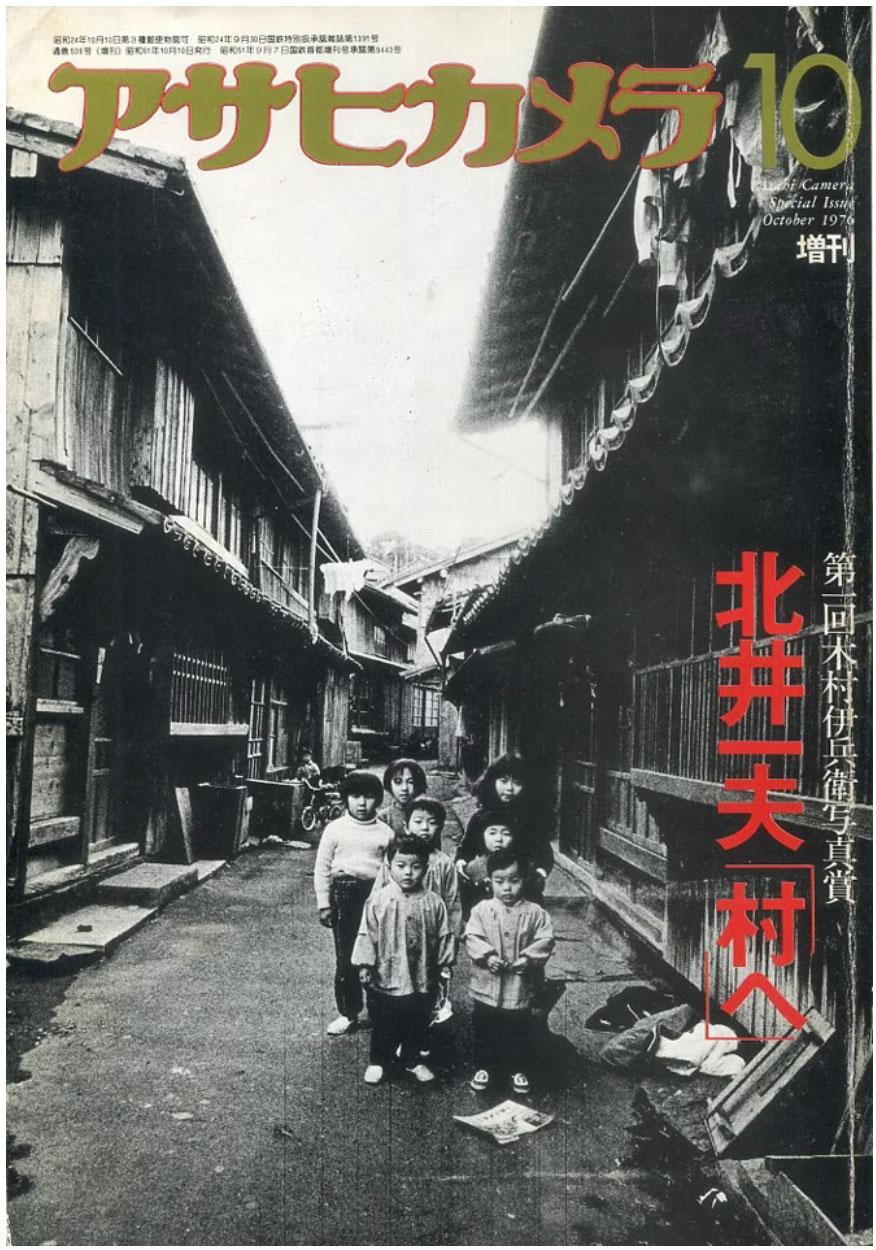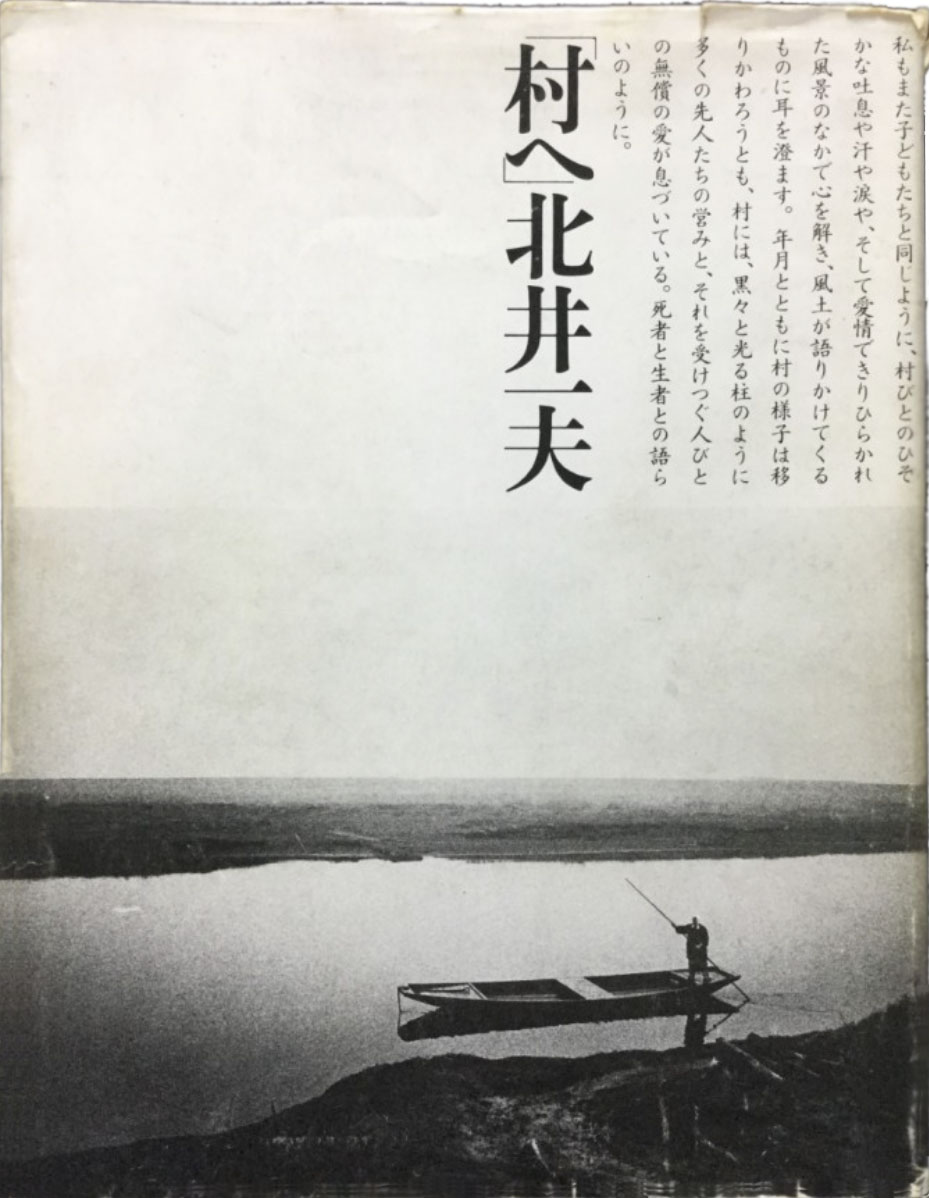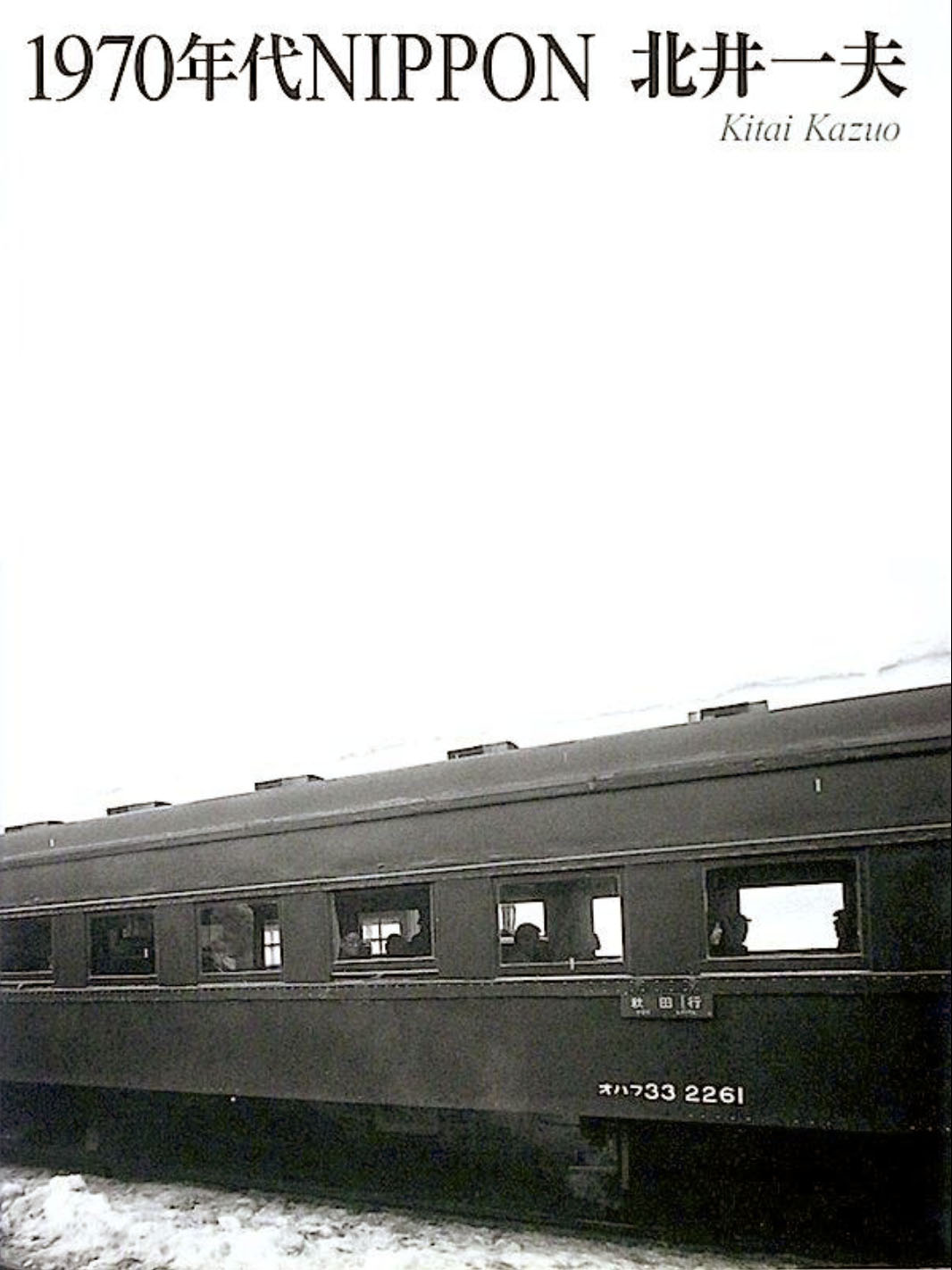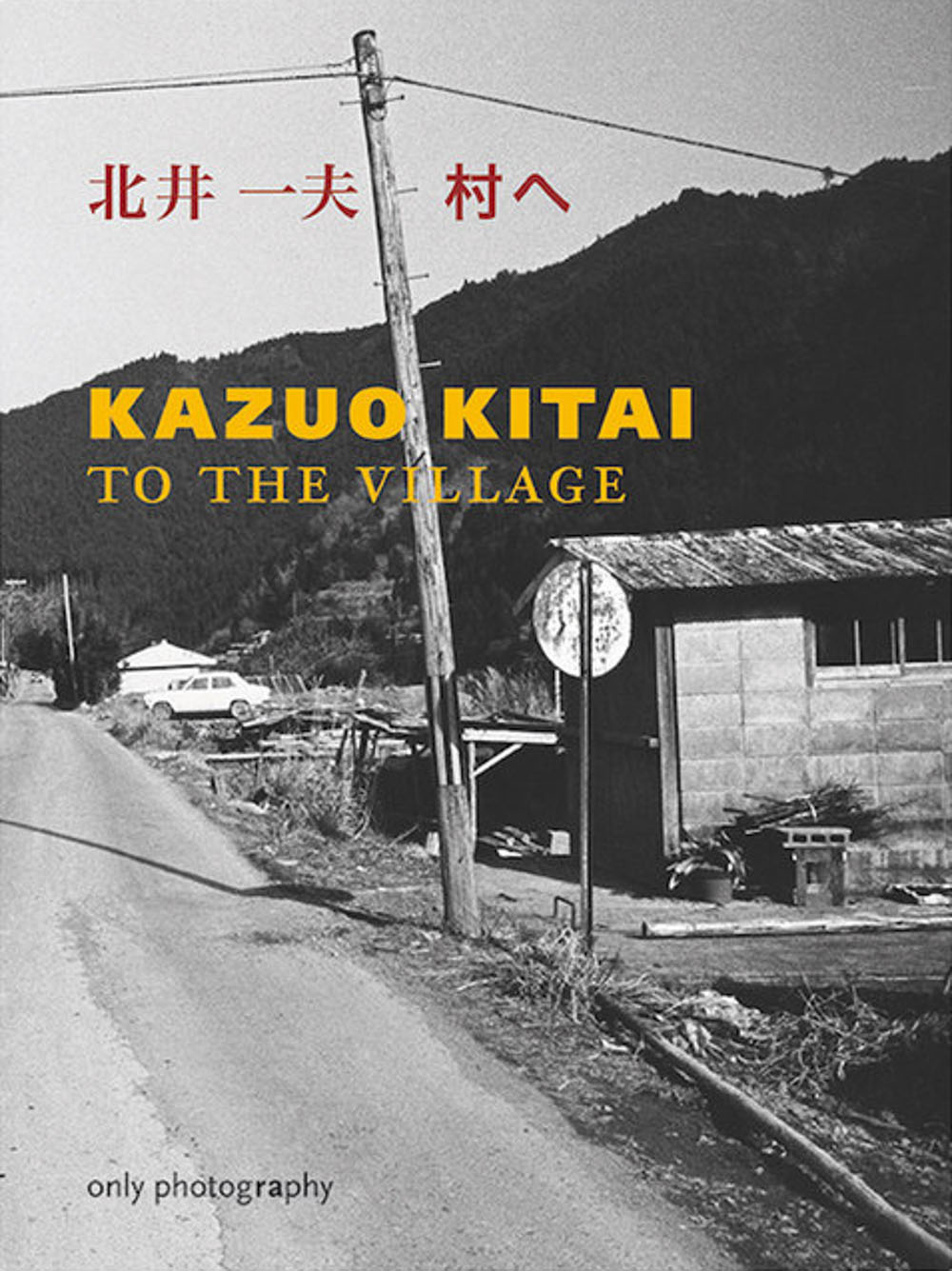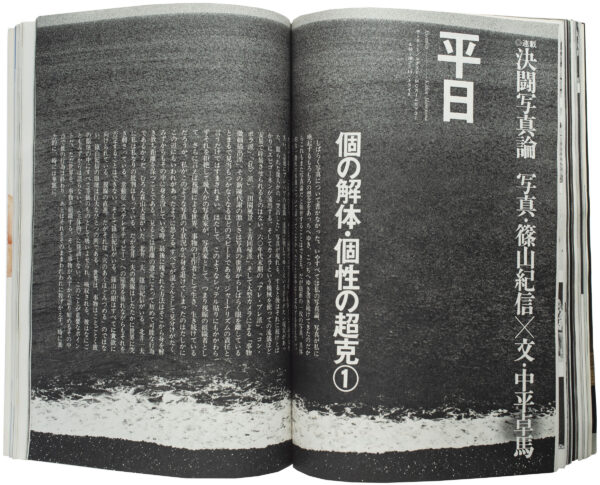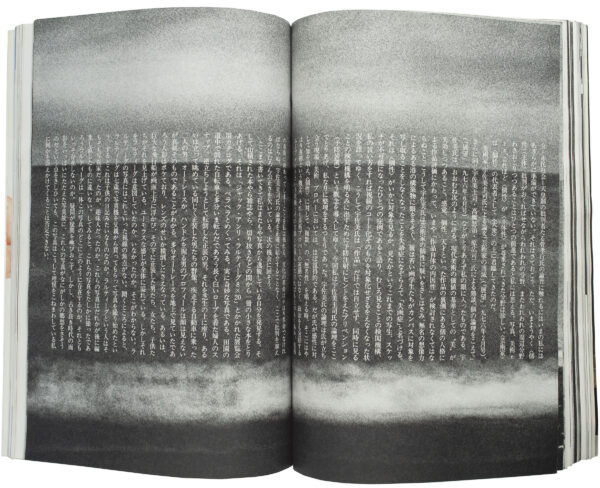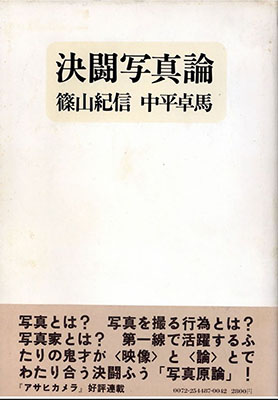Asahi Camera アサヒカメラ
April 1926 - April 1942
October 1949 - July 2020
Monthly
Founding Publisher: Asahi Shinbun-sha ( Tokyo)
Founding Editor: Narusawa Reisen
B5 size, approx. 18 x 26 cm,
Asahi Camera was suspended during the wartime, but rivived in October 1949 under the editorship of Tsumura Hideo.
The first postwar issue had a cover by Kimura Ihee. Since 1957 Kimura published his work exclusively in Asahi Camera and became in the same year Asahi’s first ‘camera doctor’ contributing a column devoted to analysis camera equipment.
After Kimura’s death in 1974, the Kimura Ihee Award was established to recognise promising young photographers.
Asahi Camera was Japan’s longest-running monthly photo magazine. It primarily featured contemporary Japanese photography, and today it is recognised as being one of the monthly circulations to influence modern Japanese photo history when it showcased the visual portfolios and photo theory of emerging as wel as established photographers.
Besides pictorials and the monthly contests (the Asahi Camera Monthly Contest), it had lots of information; equipment reviews, exhibition reviews and schedules, new books, etc.
For much of the period 1962–85, the job of photographing the cover was given to a single photographer for four or more consecutive months.
The late 1960s-into-mid-1970s is a particularly groundbreaking trail in Asahi Camera within the context of modern photo history. Year 1969, Daido Moriyama appear in every January to December issue with two now influential photo projects, «Accident» and «Premeditated or Not». In these stark monochrome Moriyama-signature works, we experience the artist transitioning towards his deconstructing iconography that is manifested in the testimonial photo books «Bye Bye Photography» (1972), «Japan, a photo theatre II» (1978) and «Light And Shadow» (1982). In addition to Mo- riyama, Asahi Camera anno 1969 presents Shomei Tomatsu’s social documentary series «Okinawa», a project that reflects on the Japanese island, its culture and the US troops deployed there. We also find numerous works by photographers Ihei Kimura, Kishin Shinoyama, Eikoh Hosoe - to recurring photo stories such as Takuma Nakahira’s «New Japanese Aestheticism» or «Eyes of Quintet» featuring noteworthy artists Yoshitaka Nakatani and Fumiaki Kuwabara.
Asahi Camera was manufactured using the gravure printing method, a photomechanical process developed for high-quality picture reproduction. The method was valued for its high-grade resolution and sharpness, qualities that in black and white or monochrome photography render exceptionally beautifully and subtle nuance gradations. The method has in our contemporary been abandoned for less expensive mass-production printing without the same technical or artistic capabilities.
On June 2020, the Asahi Shimbun Publishing announced:
‘The monthly magazine “Asahi Camera” (published on the 20th of every month) will be suspended after the July 2020 issue (released on June 19th). Due to the drastic reduction in advertising expenses due to the corona crisis, it is very unfortunate, but it has become difficult to maintain.’
The Kimura Ihei Photo Award will continue to be co-sponsored by Asahi Shimbun and Asahi Shimbun Publishing.’
Asahi Camera December 1949
Editor: Tsumura Hideo
Cover: Berenice Abott
218 pages, letterpress halftone
Left page. Hamada Hiroshi; Portrait of Uemura Shōen, who passed away earlier that year.
Uemura was a painter, pseudonym of Uemura Tsune. 1875-1949.
Right page a portrait of a young woman by Sugiyama Kira.
Left and right page: Akiyama Shotaro.
Discussion; ‘Talking about sports photography’ 5 pages.
From left to right; Hiro Kentaro (Weekly Baseball Newspaper), Abo Hisatake (Sun Shashin Shimbun Photography manager), Seki Miho (Baseball World Editor-in-Chief), Nishihashi Shintaro (Headquarters Photography manager)
Sugiyama Kira: Ratai (The Nude)
29,8 x 21,6 cm , unpaginated. Photographs in letterpress.
Preface by Kimura Ihei, Introduction by Kuwabara Kineo.
Soare Kobo, Tokyo 1951
Akiyama Shotaro: Ra ra ra ran: Sonorama shashin sensho, vol. 23 (Naked Portraits: Sonorama Photography Anthology, vol. 23 )
20,8 x 22 cm , 120 pp. Photographs in sheed-fed gravure. Author: Tanaka Masao
Asahi Sonorama Tokyo 1979
Asahi Camera May 1958
Editor: Ban Toshihiko
Cover: Iwamiya Takeji
250 pages, gravure printing
Kimura Ihei
Series “The Japanese” , 10: Elecronic Age. 5 pages
Narahara Ikko; Colorful Town 4 pages plus one gatefold.
Narahara Ikko ( 1931 - 2020 ) had his first solo exposition ‘Human Land’ in 1956 at the Matsushima Gallery, Ginza, at that time the only gallery devoted to photography in Tokyo.
In this he showed ‘Hajima’, a man-made island, famous for its coalmine. The island, surrounded by a thirty-foot concrete wall, is popularly called ‘Warship Island’. (Gunkanjima)
In his second exhibition, ‘Domains’ , in 1958 at the Fuji Photo Salon, Tokyo, he showed the series of a Trappist monastery at Tobetsu in Hokaido and at the Wakayama Prefectural Penitentiary for Females.
His 1971 book ‘Human Land’ consists of these three stories;
1. Garden of Silence ( the Trappist monastery)
2. Within the Walls ( the Female Penitentiary
3. Man and his Land. ( the Warship Island )
Okoku ( Man and his Land )
132 pp, 26,4 x 22 cm. Photographes in offset.
Hardcover, dust jacket with obi, acetate sleeve.
Chuo Koronsha, Tokyo, 1971
1. Garden of Silence
2. Within the Walls
3. Man and his Land
Asahi Camera December 1966
Editor: Koyasu Masanao
Cover: Kurigami Kazumi
306 pages, gravure printing
Kuwabara Fuminaki: Minamata Disease. 7 pages.
‘In Minamata Disease, Kuwabara has photographed the people of a small fishing village who fell victim to chemical poisoning. He was photographing these disease victims not as unrelated, objective third party, but rather telling a story from the victim’s perspective.
(..) Several years later, beginning in 1971, W.Eugene Smith also visited Minamata and created a powerful body of work, sever- al images of which have become representative of his body of work as a whole. ‘
(Kaneko Ryūchi and Ivan Vartanan; Japanese photobooks of the 1960s and 1970s. Aperture 2009)
Kuwabara Fumiaki (Shisei) - Minamata-Byō translated title: Minamata Disease (note the spelling mistake, Desease)
116 pp, 62 photographs in sheet-fed gravure. 24 x 25,7 cm
Hardcover with jacket and box.
Sanichi Shobō. 1965
Asahi Camera July 1969
Editor: Tsunoda Hideo
Cover: Kurigami Kazumi
327 pages, gravure printing
Tōmatsu Shōmei: Okinawa, Land of Discriminations, 16 pages.
First spread; right page; Kurihara Tatsuo- Okinawa students struggle.
Tōmatsu Shōmei ( 1930-2012 ) encounters with Okinawa began in 1969, at the very peak of popular protests against the Vietnam war and in support of the ‘reversion’ of Okinawa to Japanese sovereignty; he was sponsored by Asahi Camera. The purpose of his first visit was to capture the U.S. ‘occupation’ and popular protests against it, as Tōmatsu had long been doing in other parts of Japan (see: ‘Occupation’ - later chanced in ‘Chewing Gum and Chocolate,’ an open-ended series on U.S. military bases in Japan, mostly not on Okinawa, that Tōmatsu began around 1958 and expanded in a variety of magazines in the following years.) Tōmatsu’s photo reportage on Okinawa first appeared in the June and July 1969 issues of Asahi Camera, and was then published as a separate - and definitely his most political - book: ‘Okinawa, Okinawa, Okinawa.’
Tōmatsu Shōmei - Okinawa, Okinawa, Okinawa.
96 pages, photographs in sheet-fed gravure
Softcover, 21 x 26 cm
Shaken, Tokyo 1969
In 1969 Moriyama published a yearlong serialization called “Akushidento” (Accident), subtitled “Premeditated or Not,” which explored the questions: Does a photographer search for images that he has already envisioned in his mind’s eye? Or is the process of taking photographs an exploration of the universe and a means by which to engage something new?
(Ivan Vartanian in Aperture)
As the nation’s industrial expansion gained pace, over-urbanisation is becoming a serious problem. The farming population has dwindled to less than one third of the total. One farm village after another is deserted. Moriyama’s ‘All the folks gone’ was taken at such ghost village not far away from Hiroshima City which is rapidly converting itself from an administrative and consumer cen- ter to an industrial zone.
Moriyama Daido; series Accident 7. Tashiro, Yokogawa. ‘All the folks gone.’
On the first spread, right page: last image of an essay by Mori Hiroki, titled ‘Kyoto’.
Asahi Camera
June 1973
Editor: Kojima Shigeru
Cover: Takanashi Yukata
349 pages, gravure printing
Araki Nobuyoshi; ‘Women of the Past. Girl friends.
From the editor:
Versatile Parody. Those who remember Araki’s ‘Hot Landscape’ collages of two excessively grainy and irrelevant shots torn and pasted side by side, carried by last December issue of this magazine, may find it hard to belie-
ve that this issue’s ‘Girl Friends’ was authored by the same photographer. The nine girls were portrayed in nine different styles conforming to those of nine foremost Japanese photograhers. Thus Araki demonstrated what he learned while working nine years for Dentsu, Japan’s largest ad agency, before he decided to go independent on his own style. Incidentally this essay is Araki’s first color to be made public by magazine media.
He used varied cameras and three different Ektachrome in the production of this color parody.
.
Asahi Camera July 1975
Editor: Okami Akira
Cover: Sawatari Hajime
338 pages, gravure printing
Asahi Camera December 1975
Editor: Okami Akira
Cover: Sawatari Hajime
382 pages, gravure printing
Kitai’s photographs for ‘To the Village’ were serialized in twenty-four issues of the Asahi Camera monthly magazine from January 1974 to December 1975. The 1970s was a time when people in Japan were rapidly turning their attention to the cities. As if opposing this trend, Kitai chose the village as his subject, causing a stir with a fresh perspective that portrayed perfectly ordinary everyday life. Kitai was presented with the inaugural Kimura Ihei Award for this acclaimed series of photographs.
Asahi Camera July 1975
Village series 19
Hunters
From the editor:
Vanishing Tribe. Kitai covered for his Villages Series another vanishing tribe of 10 bear hunters at Ani, Akita in northern Honshu.These hunters are governmental forest rangers by profession and hunt with riffles wild, ferocious bears in a brief season from late April to early Mai. Operating in a team, these superbe hunters bag every year four to five bears, each valued at well over $ 1000 dead or alive. Kitai lived with the vanishing tribe for one week, trekking snow-covered mountains from base to top.
Asahi Camera December 1975
Village series 24
Geothermal Community
From the editor:
Gregarious Farmers. For finale of his two-year-long elaborate Village Series, Kitai lived for three days and nights with farmers vacationing at a remote hot spring in highlands of northern Honshu. Farmers of the district, mostly elderly, take vacation for a week to a month at the hot spring, near Japan’s first geothermal power station built more than a decade ago. The gregarious life of the vacationing people may endorse a theory saying that a real privacy does not exist among the Japanese.
.
Kitai Kazuo - To the Village - 1976 - published by Asahi Camera, as a special issue- 278 pages- 18 x 25,8cm
Kitai Kazuo - To the Village - 1980 - Published by Tankosha - 380 pages - 18,5 x 23,5 cm
Kitai Kazuo - 1970 Nippon - 2001 - Published by Tosei Sha - 228 pages - 18,8 x 24,4 cm
Kitai Kazuo - To the Village - 2018 - Published by Only Photography - 128 pages - 24 x 32 cm
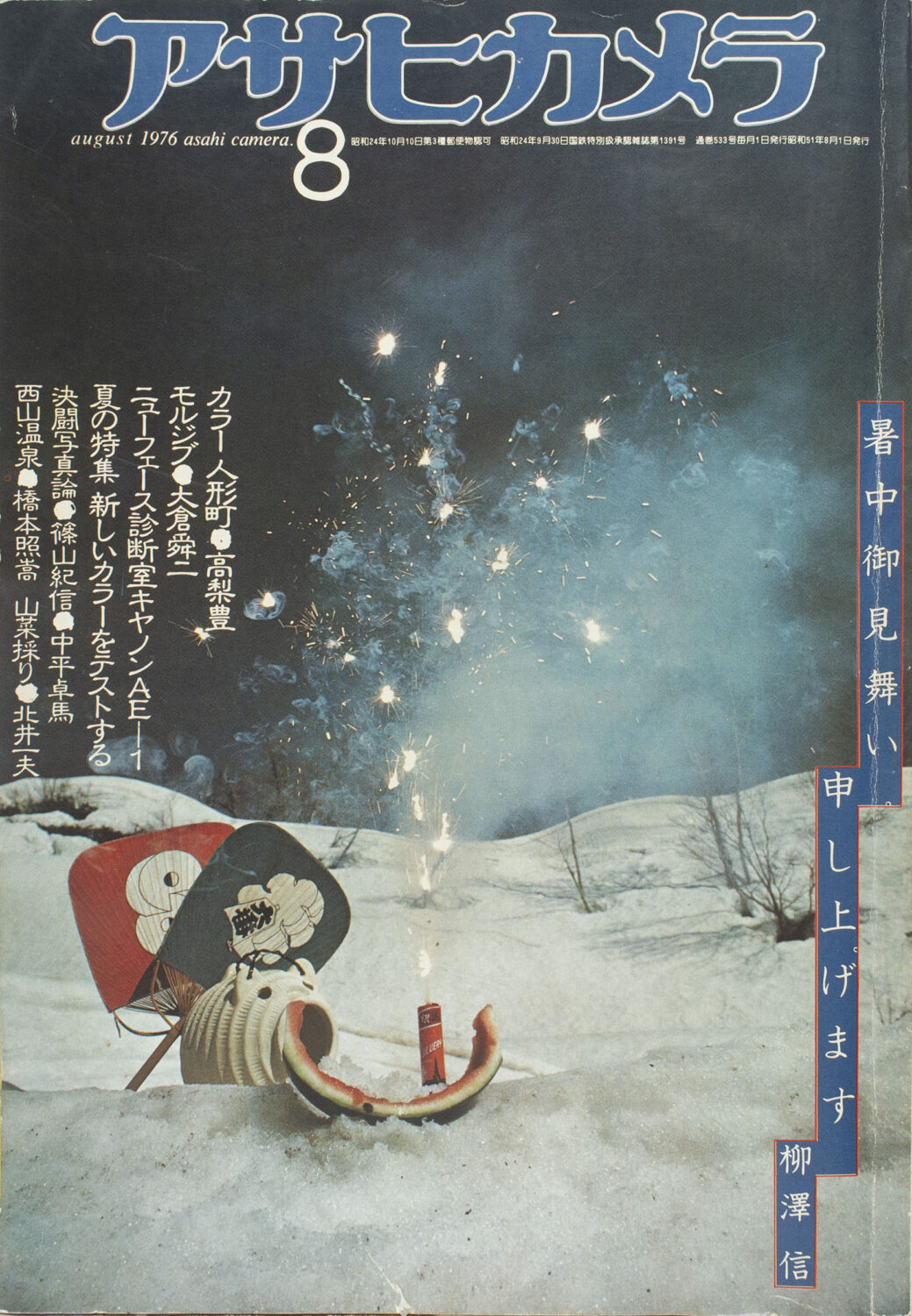
Asahi Camera August 1976
Editor: Okami Akira
Cover: Yanagisawa Shin
359 pages, gravure printing
Selection of content:
Ningyocho Tokyo, Takanashi Yutaka, 21 pages color / Maldives, Okura Shunji, 10 pages b&w / Nishiyama Hotspring, Hashimoto Shoko, 16 pages b&w / Duel on Photography, Shinoyama Kishin and Nakahira Takuma, 12 pages b&w / Angles ’76, contributions of an amateur and a freelancer, 5 pages b&w / Vilages series; Matsudai - Mountain Vegatables, Kitai Kazuo, 12 pages b&w / He is serial; Architect Isozaki Arata, Takanashi Yutaka, 6 pages b&w / New Face Clinic; Canon AE-1 / Color characteristics of Kodachrome 25 and 64 / Asahi Camera Contest; transparancies, three piece essay, theme free, small prints.
Asahi Camera August 1976
Editor: Okami Akira
Cover: Yanagisawa Shin
359 pages, gravure printing
Selection of content:
Ningyocho Tokyo, Takanashi Yutaka, 21 pages color / Maldives, Okura Shunji, 10 pages b&w / Nishiyama Hotspring, Hashimoto Shoko, 16 pages b&w / Duel on Photography, Shinoyama Kishin and Nakahira Takuma, 12 pages b&w / Angles ’76, contributions of an amateur and a freelancer, 5 pages b&w / Vilages series; Matsudai - Mountain Vegatables, Kitai Kazuo, 12 pages b&w / He is serial; Architect Isozaki Arata, Takanashi Yutaka, 6 pages b&w / New Face Clinic; Canon AE-1 / Color characteristics of Kodachrome 25 and 64 / Asahi Camera Contest; transparancies, three piece essay, theme free, small prints.
.
Kettō Shashinron ( 決闘写真論 , Duel on Photography)
This rensai ( serial) by Shinoyama Kishin and Nakahira Takuma run from January to December 1976.
Having read Nakahira’s essay “Eugène Atget: A Look at the City or a Look from the City” ( Asahi Camera July 1973) and “Things Crouched in Silence: On Walker Evans” ( Asahi Camera, July 1975) , Shinoyama asked Nakahira to review his book, Harate Hi ( A Fine Day, 1975 - see the magazine ‘Asahi Graph’ on this website )
Shinoyama’s dead pan photographs were in line with Nakahira’s thoughts about photography.
A monthly series of photos by Shinoyama and a reflection by Nakahira on this.
For the serial Nakahira’s text was printed on Shinoyama’s photographs, looking and meaning as they were one.
.
.A single volume of the series was later published as a book with the same title.
Toda Masako in Japanese Photography Magazines 1880s-1980s:
“But there was a fundamental divergence from the magazine series: the photographs and text were laid out as completely separate and independent elements, and new photographs from Shinoyama’s book Ie and Harate Hi were added. In addition, the aforementioned texts by Nakahira on Atget and Evans were included. A dialogue between the two about the rensai was printed too, making clear the larger enterprise of the project, but the actuality of battle in the serial was lost.”
.
Kettō Shashinron ( 決闘写真論 , Duel on Photography)
Publisher: Asahi Shinbunsha 1977
21,5 x 15,5 cm 328 pages, hardcover, dust jacked, obi.
